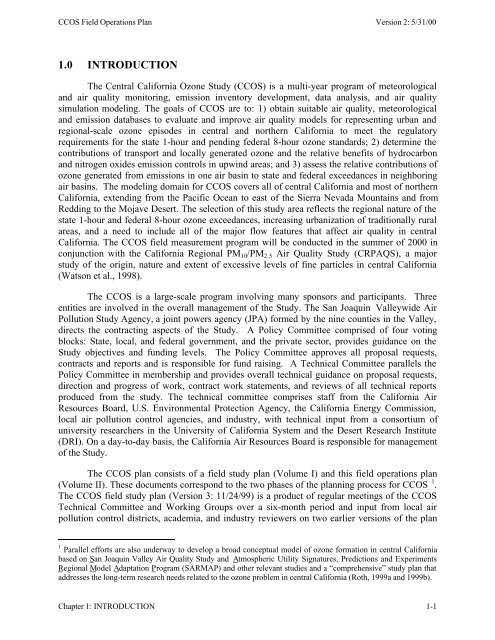Central California Ozone Study (CCOS) - Desert Research Institute
Central California Ozone Study (CCOS) - Desert Research Institute
Central California Ozone Study (CCOS) - Desert Research Institute
Create successful ePaper yourself
Turn your PDF publications into a flip-book with our unique Google optimized e-Paper software.
<strong>CCOS</strong> Field Operations Plan Version 2: 5/31/00<br />
1.0 INTRODUCTION<br />
The <strong>Central</strong> <strong>California</strong> <strong>Ozone</strong> <strong>Study</strong> (<strong>CCOS</strong>) is a multi-year program of meteorological<br />
and air quality monitoring, emission inventory development, data analysis, and air quality<br />
simulation modeling. The goals of <strong>CCOS</strong> are to: 1) obtain suitable air quality, meteorological<br />
and emission databases to evaluate and improve air quality models for representing urban and<br />
regional-scale ozone episodes in central and northern <strong>California</strong> to meet the regulatory<br />
requirements for the state 1-hour and pending federal 8-hour ozone standards; 2) determine the<br />
contributions of transport and locally generated ozone and the relative benefits of hydrocarbon<br />
and nitrogen oxides emission controls in upwind areas; and 3) assess the relative contributions of<br />
ozone generated from emissions in one air basin to state and federal exceedances in neighboring<br />
air basins. The modeling domain for <strong>CCOS</strong> covers all of central <strong>California</strong> and most of northern<br />
<strong>California</strong>, extending from the Pacific Ocean to east of the Sierra Nevada Mountains and from<br />
Redding to the Mojave <strong>Desert</strong>. The selection of this study area reflects the regional nature of the<br />
state 1-hour and federal 8-hour ozone exceedances, increasing urbanization of traditionally rural<br />
areas, and a need to include all of the major flow features that affect air quality in central<br />
<strong>California</strong>. The <strong>CCOS</strong> field measurement program will be conducted in the summer of 2000 in<br />
conjunction with the <strong>California</strong> Regional PM 10 /PM 2.5 Air Quality <strong>Study</strong> (CRPAQS), a major<br />
study of the origin, nature and extent of excessive levels of fine particles in central <strong>California</strong><br />
(Watson et al., 1998).<br />
The <strong>CCOS</strong> is a large-scale program involving many sponsors and participants. Three<br />
entities are involved in the overall management of the <strong>Study</strong>. The San Joaquin Valleywide Air<br />
Pollution <strong>Study</strong> Agency, a joint powers agency (JPA) formed by the nine counties in the Valley,<br />
directs the contracting aspects of the <strong>Study</strong>. A Policy Committee comprised of four voting<br />
blocks: State, local, and federal government, and the private sector, provides guidance on the<br />
<strong>Study</strong> objectives and funding levels. The Policy Committee approves all proposal requests,<br />
contracts and reports and is responsible for fund raising. A Technical Committee parallels the<br />
Policy Committee in membership and provides overall technical guidance on proposal requests,<br />
direction and progress of work, contract work statements, and reviews of all technical reports<br />
produced from the study. The technical committee comprises staff from the <strong>California</strong> Air<br />
Resources Board, U.S. Environmental Protection Agency, the <strong>California</strong> Energy Commission,<br />
local air pollution control agencies, and industry, with technical input from a consortium of<br />
university researchers in the University of <strong>California</strong> System and the <strong>Desert</strong> <strong>Research</strong> <strong>Institute</strong><br />
(DRI). On a day-to-day basis, the <strong>California</strong> Air Resources Board is responsible for management<br />
of the <strong>Study</strong>.<br />
The <strong>CCOS</strong> plan consists of a field study plan (Volume I) and this field operations plan<br />
(Volume II). These documents correspond to the two phases of the planning process for <strong>CCOS</strong> 1 .<br />
The <strong>CCOS</strong> field study plan (Version 3: 11/24/99) is a product of regular meetings of the <strong>CCOS</strong><br />
Technical Committee and Working Groups over a six-month period and input from local air<br />
pollution control districts, academia, and industry reviewers on two earlier versions of the plan<br />
1 Parallel efforts are also underway to develop a broad conceptual model of ozone formation in central <strong>California</strong><br />
based on San Joaquin Valley Air Quality <strong>Study</strong> and Atmospheric Utility Signatures, Predictions and Experiments<br />
Regional Model Adaptation Program (SARMAP) and other relevant studies and a “comprehensive” study plan that<br />
addresses the long-term research needs related to the ozone problem in central <strong>California</strong> (Roth, 1999a and 1999b).<br />
Chapter 1: INTRODUCTION 1-1
















